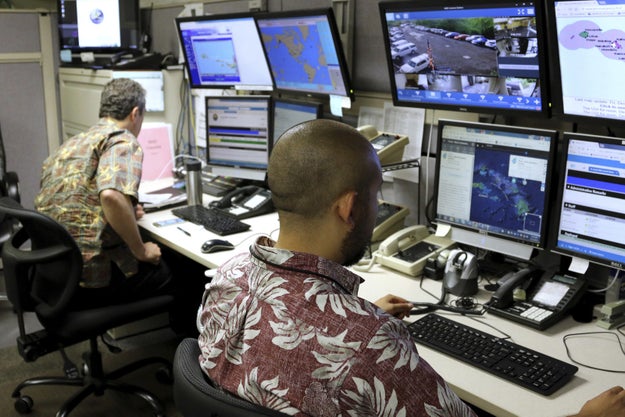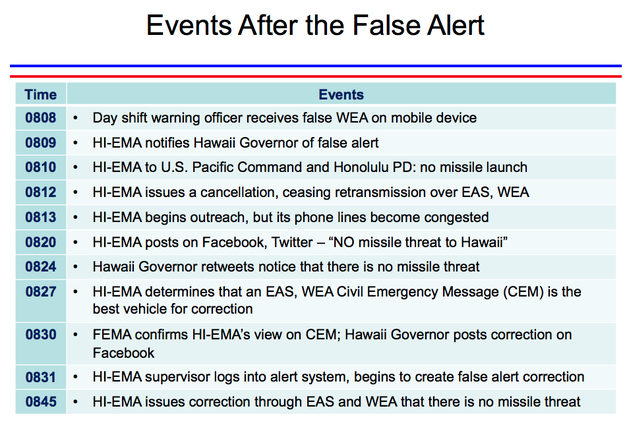
Hawaii Emergency Management Agency officials at the department's command center in Honolulu.
Caleb Jones / AP
The emergency worker who sent an incorrect warning message to residents of Hawaii alerting them to an incoming ballistic missile on Jan. 13, actually believed the threat was real, a preliminary investigation found.
According to a report released on Tuesday by the Federal Communications Commission, the decision of a Hawaii Emergency Management Agency (EMA) night-shift supervisor to conduct an unannounced ballistic missile defense drill began the chain of events that led to 38-minutes of widespread panic and fear.
The midnight-shift supervisor intended to test the day-shift staff with an unannounced drill, but because of a verbal miscommunication between the midnight-shift and day-shift supervisor, the latter believed the drill was intended for the night-shift, and therefore was unprepared and unaware for the drill.
"At 8:05 a.m., the midnight shift supervisor initiated the drill by placing a call to the day shift warning officers, pretending to be U.S. Pacific Command," the report read, which noted that this was normal protocol.
The midnight shift supervisor then played a recording that began with the words, “Exercise, exercise, exercise." But the rest of the message, which was not in accordance with the Hawaii EMA’s standard operating procedures and was a recording for "an actual live ballistic missile alert," also said, “this is not a drill.”
According to a statement from the day shift warning officer who eventually would issue the false alert, the officer said he heard the words “this is not a drill,” and did not hear “exercise, exercise, exercise.”
The day shift warning officer believed there was an incoming ballistic missile heading towards the Hawaiian islands and used the agency's software to send out the alert.
"BALLISTIC MISSILE THREAT INBOUND TO HAWAII. SEEK IMMEDIATE SHELTER. THIS IS NOT A DRILL," read the alert to people's phones, which immediately caused a panic among residents and on social media who wondered if the next minutes would be their last.
While other officers told the FCC investigators that they knew the phone call was a drill, the officer at the alert terminal, who has refused to talk to investigators and has instead provided the statement, went ahead with the procedure for sending out an alert.
"The day shift warning officer seated at the alert origination terminal, however, reported to the Hawaii Emergency Management Agency after the event their belief that this was a real emergency, so they clicked 'yes' to transmit the alert," the report stated.
"Because we’ve not been able to interview the day shift warning officer who transmitted the false alert, we’re not in a position to fully evaluate the credibility of their assertion that they believed there was an actual missile threat and intentionally sent the live alert (as opposed to believing that it was a drill and accidentally sending out the live alert)," the report read.
"But it is worth noting that they accurately recalled after the event that the announcement did say 'This is not a drill.'"

FCC / Via transition.fcc.gov
Hawaii Governor David Ige was notified one minute after the alert that it was indeed a mistake.
"At 8:10 a.m.," two minutes after the alert was sent out, "the Director of the Hawaii Emergency Management Agency communicated to United States Pacific Command that there was no missile launch, confirming what Pacific Command already knew," the report read.
For the next 13-minutes, Hawaii's EMA alerted "county emergency management agencies and radio and TV stations to inform them that the alarm was false" while the "agency’s phone lines also became congested with incoming calls from the public asking about the nature of the alert that they just received."
Twelve-minutes after the erroneous alert, Hawaii's EMA posted on Facebook and Twitter, writing "NO missile threat to Hawaii."
Hawaii's Governor retweeted the tweet. But why didn't the governor Tweet that the alert was false much earlier? He forgot his Twitter password, the report stated.
Since no operating procedure was in place to correct a false alert, it took 38-minutes to draft a correction, agree on the language, and send the correction out to residents.
"A combination of human error and inadequate safeguards contributed
to the transmission of this false alert," the preliminary report states in its finding.
LINK: The Hawaii Employee Who Sent The False Missile Alert Is Refusing To Cooperate With The Investigation
LINK: A False Alarm "Missile Threat" Warning Got Sent To Everyone In Hawaii
LINK: This Is What My Family And I Did In Hawaii When We Thought We Were Under Attack
from BuzzFeed - USNews http://ift.tt/2rRdvt1
No comments:
Post a Comment